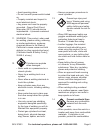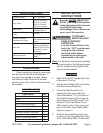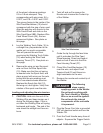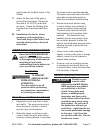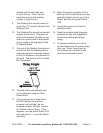
Page 18SKU 97503 For technical questions, please call 1-800-444-3353.
TROUBLESHOOTING
DANGER
Important! Be
CERTAIN to shut off the Welder,
disconnect it from power, and
discharge the torch to ground before
adjusting, cleaning, or repairing the
unit.
Wire feed motor runs but wire does not
feed properly.
Possible Causes and Solutions:
Insufcient wire feed pressure: •
Increase wire feed pressure.
Incorrect wire feed roll size: •
Replace with the proper size.
Damaged torch, cable, or liner •
assembly:
Have a qualied technician
inspect these parts and replace as
necessary.
Wire creates a bird’s nest During
operation.
Possible Causes and Solutions:
Excess wire feed pressure: •
Adjust wire feed pressure.
Incorrect contact tip size: •
Replace with the proper tip for the
wire size used.
Gun end not inserted into drive •
housing properly:
Loosen gun securing bolt and push
gun end into housing just enough
so that it does not touch wire feed
mechanism.
Damaged liner: •
Have a qualied technician inspect
and repair/replace as necessary.
Welding arc not stable.
Possible Causes and Solutions:
Wire not feeding properly: •
See rst Troubleshooting section
above.
Incorrect contact tip size: •
Replace with the proper tip for the
wire size used.
Incorrect wire feed speed: •
Adjust wire feed speed to achieve a
more stable arc.
Loose torch cable or ground cable: •
Check to ensure that all
connections are tight.
Damaged torch or loose connection •
within torch:
Have a qualied technician inspect
and repair/replace as necessary.
Welder does not function when
switched on
Possible Causes and Solutions:
Tripped thermal protection device: •
Shut the welder’s switch to off
and allow it to cool for at least 20
minutes.
Reduce duration or frequency of
welding periods to help reduce wear
on the welder.
Refer to Duty Cycle section.
Faulty or improperly connected •
Switch Body:
Have a technician check and
secure/replace Switch Body.
Internal fuse blown: •
Have a qualied technician check/
replace.
Weak Arc strength
Possible Cause and Solution:



